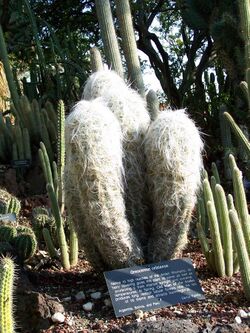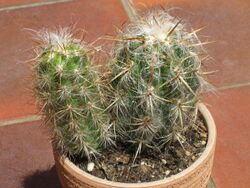Biology:Oreocereus celsianus
| Oreocereus celsianus | |
|---|---|

| |
| Scientific classification | |
| Kingdom: | Plantae |
| Clade: | Tracheophytes |
| Clade: | Angiosperms |
| Clade: | Eudicots |
| Order: | Caryophyllales |
| Family: | Cactaceae |
| Subfamily: | Cactoideae |
| Genus: | Oreocereus |
| Species: | O. celsianus
|
| Binomial name | |
| Oreocereus celsianus (Salm-Dyck) A.Berger ex Riccob.
| |
| Synonyms[1] | |
| |
Oreocereus celsianus, or the old man of the mountain is a member of the family Cactaceae native to the high lands of the Andes in South America, and is named for its fluffy white hair, which may protect it from intense sunlight and extreme temperatures.
Distribution
Oreocereus celsianus occurs naturally at high altitudes across northern Argentina and southern Bolivia.
Description
Growing to around 3 metres (10 ft) tall, O. celsianus is covered in a downy white hair, with greatest density at the tips of stems receding to near-bare at the base. The ribbed body, typically with eleven ribs, has many long, brown spines and blooms in spring with long, tubular red flowers.
Ecology
Pollinated by hummingbirds in spring.
Cultivation
Thrives at 10–12 °C (50–54 °F), with a frost-tolerance of down to −12 °C (10 °F) and requiring protection from hot sunlight. Prefers full sun and light watering. Propagates from seed.
References
Wikidata ☰ Q310346 entry


